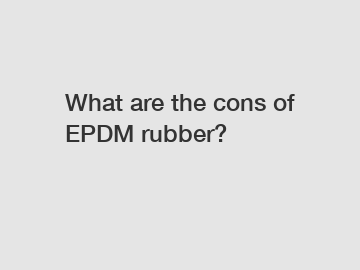What are the cons of EPDM rubber?
EPDM rubber, also known as ethylene propylene diene monomer rubber, is a popular synthetic rubber material used in a wide range of applications due to its excellent resistance to weathering, ozone, UV light, and chemicals. While EPDM rubber offers numerous benefits, it also has certain disadvantages that should be taken into consideration. In this article, we will explore some of the cons of EPDM rubber.
**Cost**.
One of the primary drawbacks of EPDM rubber is its cost. EPDM rubber tends to be more expensive than some other types of rubber materials, such as natural rubber or SBR (styrene-butadiene rubber). This higher cost can make EPDM rubber less attractive for budget-conscious projects or applications where cost is a major factor.

**Limited Temperature Range**.
Another con of EPDM rubber is its limited temperature range. While EPDM rubber is known for its excellent weather resistance, it has a lower maximum temperature limit compared to some other rubber materials. EPDM rubber typically has a maximum operating temperature of around 300°F, which may not be suitable for high-temperature applications where temperatures exceed this limit.
**Low Abrasion Resistance**.
EPDM rubber also has relatively low abrasion resistance compared to other rubber materials. This means that EPDM rubber may not be the best choice for applications where the material will be subjected to frequent rubbing or friction, as it may wear out more quickly than other rubber options.
**Poor Resistance to Petroleum-Based Oils**.
While EPDM rubber offers excellent resistance to many chemicals and solvents, it has poor resistance to petroleum-based oils and fuels. Exposure to these types of substances can cause the EPDM rubber to degrade and lose its physical properties over time. This limitation makes EPDM rubber unsuitable for applications where prolonged contact with petroleum-based oils is expected.
**Limited Compatibility with Some Roofing Systems**.
EPDM rubber is commonly used in roofing applications due to its weather resistance and durability. However, EPDM rubber may not be compatible with certain roofing systems or materials, which can limit its use in certain roofing projects. It is important to check with roofing manufacturers and experts to ensure that EPDM rubber is the right choice for the specific roofing system being used.
**Conclusion**.
While EPDM rubber offers many advantages, such as excellent weather resistance, UV resistance, and chemical resistance, it also has its drawbacks. These cons include higher costs, limited temperature range, low abrasion resistance, poor resistance to petroleum-based oils, and limited compatibility with some roofing systems. Despite these limitations, EPDM rubber remains a popular choice for a variety of applications due to its many benefits.
In conclusion, when considering EPDM rubber for a project, it is important to weigh the pros and cons carefully to determine if it is the right material for the job. By understanding the disadvantages of EPDM rubber, you can make an informed decision that meets your project's requirements. If you have any questions or need assistance with selecting the right rubber material for your application, feel free to contact us.
Contact us for more information on EPDM rubber and other rubber materials.
Are you interested in learning more about custom sponge strips manufacturer, wholesale u shaped seal strip manufacturer, Rubber Window Seal Manufacturers? Contact us today to secure an expert consultation!


